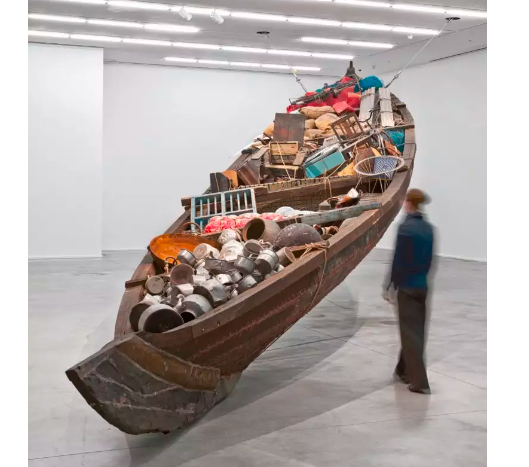In 2012, Bose Krishnamachari and Riyas Komu launched the Kochi Biennale with a noteworthy artwork by Subodh Gupta that included a gigantic Kerala kettuvallam (big boat used to transport rice) filled with containers, utensils, and things from everyday life. The sentence "What does the vessel contain that is not in the river" is taken from Jalal ad-Din Muhammad Rum's "The Sufi Path of Love." The Arario Museum paid a substantial price to acquire the Kochi Biennale exhibition that was on show in Hauser & Wirth's Savile Row gallery in 2013.
Another work by Subodh Gupta from the same year depicted a large Keralan fishing boat with nothing but black water pots hanging from and pouring out of it. In a conversation with me after the Kochi Biennale, Subodh said, "When I look at a pot or utensil, I am not presenting only the pot, but the narratives of the folks who used the pot or utensil." Uncountable stories of people's lives, worries, and joys can be found in a single discovered object. Subodh's pot has been used as a stand-in and a metaphor for a person's life for a long time. When it was on show in London, the traditional Keralan boat, which was over 20 meters wide in the middle when it was on display at the Kochi Biennale, covered the whole length of the gallery.
It was crammed from bow to tail with seats, mattresses, window frames, fishing nets, plastic jars, cans, an ancient radio, cooking pots and pans, bags, and a bicycle, echoing the notion of the microcosm, the confinement of a whole cosmos within the human spirit (reflected in Rumi's poetry). According to Subodh, this boat was stuffed with goods and was like a microcosm of one person's entire life.
The boat for Subodh finally evolved into an extension of the greater paradigm of survival, sustenance, and livelihood. It was more than just a way to go around. A global symbol was featured in his 2012 Jal Mein Kumbh, Kumbh Mein Jal Hai boat installation. The hanging black pots served as a symbol of the harm that industrialization and globalization had done.
The alluring brass black pots resembled Kabir's well-known ghat scene from "Is ghat mein saat samundar" in various ways.
It wouldn't be unfair to claim that the tension between the container and the substance is a parable for a concern for the marginalized members of consumer society, especially for those who are economically thrown out and forced to survive on the leftovers of a feast they were not invited to. Subodh's ability to create a spectacle that speaks to every human eye that he looks at is what has made him successful as an installation artist over the years using the language of the ordinary.
The two pieces offer viewers the choice of seeing them with skepticism or by looking more closely in order to discover the different layers of story that coexist and appear as a result of the use of objects as symbols of identity and memory. Then many stories are conveyed in everyday words. Kabir has long used literary allusions to inspire the titles of his installations, which span numerous oceans.
According to Subodh Gupta, Kabir is a great mystic whose concept of the One connects all major religions. His couplets, recited by so many, have stood the test of time. These two Kerala boat installations, made by a poet who can recite Kabir's couplets off-hand, relate the container to the content as well as the living and the quality of life.




No comments:
Post a Comment